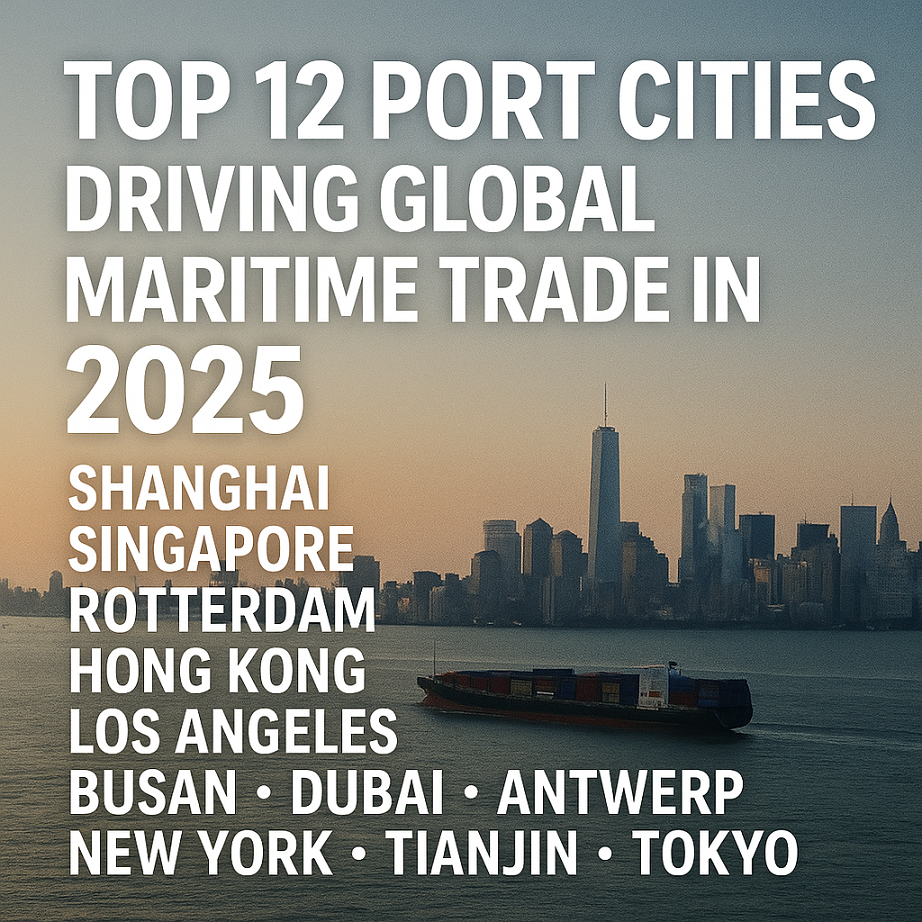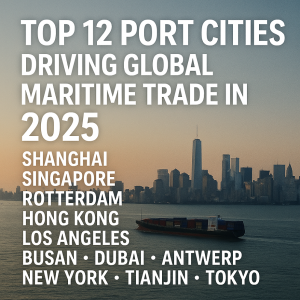Why Port Cities Matter in 2025
In today’s interconnected world, over 80% of global trade by volume moves by sea (UNCTAD, 2024). At the heart of this immense system are the port cities—strategic gateways where ships, cargo, and economies converge. From mega-container hubs in Asia to transshipment powerhouses in Europe and energy-export terminals in the Middle East, these cities are more than just points on a map. They are economic lifelines, shaping the rhythm of global trade, influencing supply chains, and driving regional development.
As 2025 unfolds, geopolitical tensions, sustainability targets, and digital innovations are reshaping maritime logistics. Understanding which 12 port cities lead the way helps us not only track trade flows but also anticipate the future of shipping.
The Role of Port Cities in Global Maritime Trade
Port cities are more than infrastructure—they are living ecosystems where shipping meets finance, manufacturing, and culture. Cities like Shanghai and Singapore are not just ports; they are global economic capitals. The role of port cities in 2025 can be grouped into three categories:
- Gateway Ports: Serving massive hinterlands (e.g., Shanghai, Rotterdam).
- Transshipment Hubs: Specializing in cargo redistribution (e.g., Singapore, Dubai).
- Specialized Ports: Focused on oil, gas, or bulk commodities (e.g., Houston, Fujairah).
These cities handle millions of TEUs (twenty-foot equivalent units) annually, competing fiercely for efficiency, sustainability, and digital transformation.
The Top 12 Port Cities of 2025
Each of the following ports is presented with background, trade volumes, and future outlook.
1. Shanghai, China – The World’s Busiest Container Port
Shanghai has been the undisputed leader in container throughput for more than a decade. Handling over 47 million TEUs in 2023 (UNCTAD), it serves as the backbone of China’s export-driven economy. The Yangshan Deep-Water Port, linked by the world’s longest sea bridge, positions Shanghai as a symbol of maritime power.
2025 Outlook: Shanghai is doubling down on automation and green shipping corridors, aligning with IMO’s 2050 net-zero targets.
2. Singapore – The Transshipment Titan
Singapore sits at the crossroads of East-West trade, with nearly 1,000 ship calls daily (Maritime and Port Authority of Singapore). The new Tuas Mega Port, scheduled for full completion in the 2030s, will handle up to 65 million TEUs annually, consolidating its role as the world’s largest automated port.
2025 Outlook: Singapore is positioning itself as a smart port leader, integrating blockchain-based cargo tracking and LNG bunkering.
3. Rotterdam, Netherlands – Europe’s Maritime Gateway
Rotterdam is Europe’s largest port and a vital link for energy, containers, and bulk cargo. With access to the Rhine–Meuse–Scheldt delta, it connects Northern Europe’s industrial heartland to global markets. Rotterdam also leads in green hydrogen imports and offshore wind logistics.
2025 Outlook: Rotterdam aims to become the first carbon-neutral port in Europe, aligning with the EU Green Deal.
4. Dubai (Jebel Ali), UAE – Middle East Logistics Powerhouse
Jebel Ali Port, operated by DP World, is the largest port in the Middle East and a vital transshipment hub for the Indian Ocean region. It connects over 140 ports globally, making Dubai a logistics hub for trade between Asia, Africa, and Europe.
2025 Outlook: Expansion plans include digital twin systems for port operations and further capacity increases for bulk energy exports.
5. Los Angeles & Long Beach, USA – The Twin Giants of North America
Together, the Ports of Los Angeles and Long Beach handle over 30% of U.S. containerized imports. They are the main gateway for Asia–U.S. trade, particularly from China and Japan. Despite congestion challenges during the pandemic, they remain critical to supply chains.
2025 Outlook: Focus on zero-emission cargo handling equipment and investments in offshore wind energy infrastructure.
6. Busan, South Korea – Northeast Asia’s Logistics Hub
Busan is South Korea’s largest port, handling nearly 23 million TEUs annually. It plays a critical role in connecting Korean exports—cars, electronics, and steel—to global markets.
2025 Outlook: Expansion of the Busan New Port will increase capacity while enhancing automation.
7. Hong Kong, China – Once a Leader, Still a Key Player
Though Hong Kong has slipped in rankings, it remains a vital transshipment hub for South China. The port’s free-trade status and advanced logistics still attract shipping alliances.
2025 Outlook: Hong Kong is betting on logistics-tech integration to regain competitiveness against Shenzhen and Guangzhou.
8. Antwerp-Bruges, Belgium – Europe’s Rising Star
Following its 2022 merger, the Port of Antwerp-Bruges became Europe’s second-largest container hub after Rotterdam. It specializes in chemicals and logistics for Europe’s manufacturing base.
2025 Outlook: Heavy investment in hydrogen bunkering and carbon capture infrastructure.
9. Hamburg, Germany – The Hanseatic Legacy
Germany’s largest port remains a cornerstone of European trade. With strong rail connections, Hamburg is crucial for linking Eastern Europe with global markets.
2025 Outlook: Hamburg is investing in shore power facilities for cruise and container ships, supporting EU decarbonization policies.
10. Tokyo & Yokohama, Japan – Gateways to Japan’s Economy
The Tokyo–Yokohama port complex is Japan’s busiest maritime hub, handling millions of TEUs annually. It serves as the nation’s primary connection for exports in automobiles and technology.
2025 Outlook: Japanese ports are focusing on AI-driven logistics and offshore renewable energy support.
11. Houston, USA – The Energy Export Giant
Houston is North America’s largest energy port, central to the export of crude oil, LNG, and chemicals. With the U.S. as a major energy supplier, Houston’s role in global energy security is unmatched.
2025 Outlook: LNG terminal expansions will boost Houston’s significance in the global gas trade.
12. Shenzhen, China – A Rising Powerhouse
Shenzhen is one of China’s fastest-growing ports, benefiting from its proximity to the Pearl River Delta manufacturing hub. It rivals Hong Kong in transshipment and has strong connections to electronics exports.
2025 Outlook: Shenzhen is adopting 5G-powered port automation and renewable energy integration.
–
Global Trends Reshaping Port Cities
-
Digitalization & Smart Ports – blockchain, AI, and digital twins.
-
Sustainability Pressure – IMO GHG strategy, EU Emissions Trading Scheme (ETS).
-
Geopolitical Shifts – Red Sea disruptions, Arctic route opportunities.
-
Port Competition – Alliances, mergers, and regional rivalries.
Case Studies in Port Innovation
-
Rotterdam’s Hydrogen Hub – Europe’s energy transition gateway.
-
Singapore’s Tuas Mega Port – the largest automated port under construction.
-
Los Angeles’ Green Port Plan – zero-emission cargo handling.
FAQ Section
Q1: What is the largest port city in the world in 2025?
Shanghai remains the world’s busiest container port, handling over 47 million TEUs.
Q2: Which port city is the biggest transshipment hub?
Singapore leads as the premier global transshipment hub.
Q3: What is a port city’s role in global trade?
Port cities act as gateways, transshipment centers, and logistics hubs linking producers to consumers.
Q4: How are port cities adapting to climate change?
By investing in green fuels, shore power, flood defenses, and emissions monitoring.
Q5: Which U.S. ports are most important in 2025?
Los Angeles, Long Beach, and Houston remain vital for containers and energy exports.
Q6: Are European ports losing competitiveness to Asia?
While Asia dominates in volume, European ports lead in green and digital innovation.
Conclusion
From Shanghai’s mega-terminals to Rotterdam’s hydrogen corridors, the top 12 port cities of 2025 represent the beating heart of global maritime trade. They are where economies connect, supply chains converge, and the future of shipping unfolds. As sustainability, technology, and geopolitics reshape trade, these ports will remain critical anchors of globalization.



THX